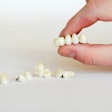Bisphenol A (BPA) temporarily leaches into patients' saliva and urine after the placement of resin-based composite dental restorations, according to a new study in the Journal of the American Dental Association (December 2012, Vol. 143:12, pp. 1292-1302).
The study analyzed saliva and urine from 172 participants who received composite restorations before and as long as 30 hours after placement of the restorations. The researchers analyzed saliva specimens from 151 participants and urine specimens from 171 participants for concentrations of BPA and five related compounds by using liquid chromatography/mass spectrometry.
They found that salivary concentrations of BPA increased immediately (within one hour) after composite placement but returned to prerestoration levels within eight hours. BPA in urine increased 43% and returned to prerestoration levels nine to 30 hours after the restorations were placed.
Concentrations in saliva were lower when a rubber dam was used, the researchers noted. However, rubber dams appeared to have no effect on urinary concentrations of BPA. The study found similar changes in both saliva and urine between patients who received anterior restorations and those who received posterior restorations.
Animal studies have associated BPA -- which is used in some dental sealants -- with breast and prostate cancers, as well as reproductive and behavioral abnormalities. In addition, some research has tied BPA to cardiovascular disease, miscarriage, decreased semen quality, and childhood behavioral issues. The chemical also may affect metabolism, diabetes, and obesity, although more studies are required to determine its effects.



















